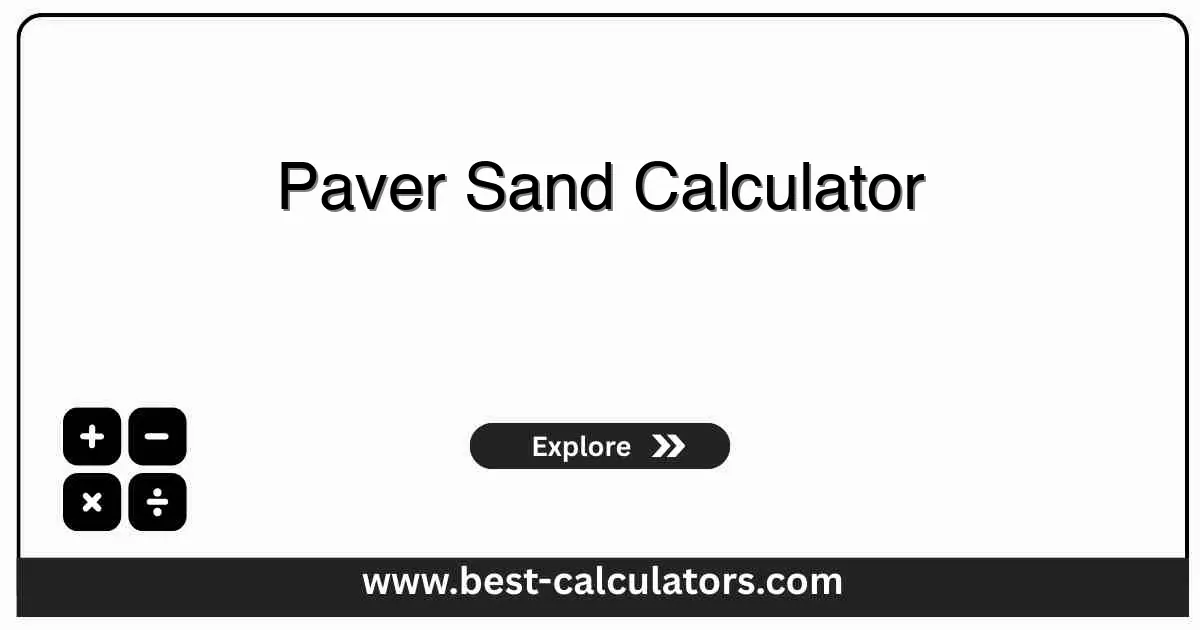Paver Sand Calculator - Bedding & Joint Sand
Calculate the exact amount of sand needed for your paver project. Estimates bedding sand volume and joint sand bags for patios and walkways.
Project Dimensions
Materials Needed
What is Paver Sand?
Paver Sand refers to two distinct layers of material used in hardscaping. First, Bedding Sand is a 1-inch layer of coarse sand that sits directly on top of your compacted gravel base. It provides a smooth, level surface to seat the pavers. Second, Joint Sand (often Polymeric Sand) is fine sand swept into the gaps between pavers to lock them together and prevent weeds.
Calculating the correct amount of both is crucial. Too little bedding sand makes leveling impossible; too much leads to sinking. Running out of expensive polymeric sand mid-project is a costly hassle.
Common uses include:
- Patios: Creating a level outdoor living space.
- Walkways: Ensuring a stable, trip-free path.
- Driveways: Providing a cushion for heavy vehicle loads.
To calculate the number of pavers and base material required, use our Paver Calculator for a complete project estimate.
For estimating the gravel base underneath the sand, check our Gravel Calculator to ensure a solid foundation.
To convert your material needs into tons for bulk ordering, try our Cubic Yards to Tons Calculator.
For securing the edges of your patio, check our Concrete Calculator for edge restraint bedding.
To plan retaining walls around your patio, use our Retaining Wall Calculator for block and backfill estimates.
How the Calculation Works
The calculator determines volume based on your area and depth settings:
For example, a 100 sq ft patio with 1 inch of bedding sand:
- Volume = 100 × (1 / 12) = 8.33 cubic feet.
- Cubic Yards: 8.33 / 27 = 0.31 cu yds.
- Weight: Dry sand weighs ~100-110 lbs per cu ft.
8.33 × 105 = 875 lbs (approx 0.44 tons). - Bags: 875 lbs / 50lb bag = 17.5 bags (Round up to 18).
Key Concepts Explained
Polymeric Sand
A specialized mixture of fine sand and polymers. When wetted, it hardens like flexible mortar, locking pavers in place and preventing ant hills and weed growth.
Concrete Sand
Also known as ASTM C33. It is coarse, washed, and angular. It allows water to drain freely and compacts slightly but not completely, making it perfect for bedding.
Screeding
The process of smoothing the bedding sand to a perfectly flat, uniform thickness using a straight board (screed) run along guide rails (usually 1" pipes).
Compaction
Bedding sand is NOT compacted before laying pavers. Compaction happens after pavers are placed, using a plate compactor to seat them into the sand layer.
How to Use This Calculator
Measure Area
Calculate the length x width of your patio in feet.
Set Depth
Enter bedding depth. Keep default 1" for most projects.
Calculate
View total volume and bag estimates.
Plan Order
Decide between bulk delivery (yards) or bags.
Benefits of Using This Calculator
- • Project Accuracy: Prevents the common mistake of guessing "a truckload" and ending up with a pile of sand in your driveway for years.
- • Logistics Planning: Helps you determine if you can haul the material in a pickup truck (up to 1 ton usually) or if you need to pay for delivery.
- • Joint Sand Budgeting: Polymeric sand is expensive ($25-40/bag). Getting a realistic estimate helps you budget for this finishing touch.
Factors That Affect Your Results
1. Paver Shape & Style
This calculator estimates joint sand for standard rectangular pavers. If you use tumbled pavers, cobblestones, or flagstone with wide, irregular gaps, you will need significantly more joint sand (sometimes 2-3x more).
2. Waste Factor
We recommend adding 5-10% to your order. Sand spills, gets kicked around, or is used to level out minor dips in the gravel base. It is always better to have 2 extra bags than to drive back to the store for one.

Frequently Asked Questions (FAQ)
Q: Can I put pavers directly on dirt?
A: No. You need a compacted gravel base (typically 4-6 inches deep) followed by 1 inch of bedding sand. The gravel provides strength and drainage, while the sand provides a smooth seating layer. Pavers on dirt will sink and shift after the first rain.
Q: What if my sand layer is 2 inches thick?
A: Too thick! Sand doesn't compact into a solid structural layer like gravel does. A deep sand layer remains "squishy," causing pavers to rock, settle unevenly, and create ruts where you walk. Stick to 1 inch maximum.
Q: How much does a cubic yard of sand weigh?
A: Approximately 2,700 to 3,000 lbs (1.35 to 1.5 tons), depending heavily on moisture content. Wet sand is much heavier than dry sand. Always check your vehicle's payload capacity before hauling.
Q: When do I apply joint sand?
A: Apply joint sand only after all pavers are laid and edge restraints are installed. Sweep it into joints, vibrate/tamp the pavers to settle the sand, add more sand to fill the drop, sweep clean, and then wet it to activate (if polymeric).